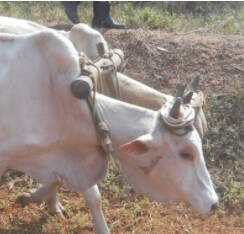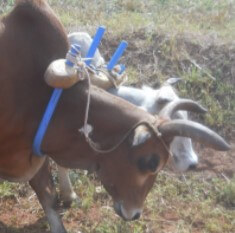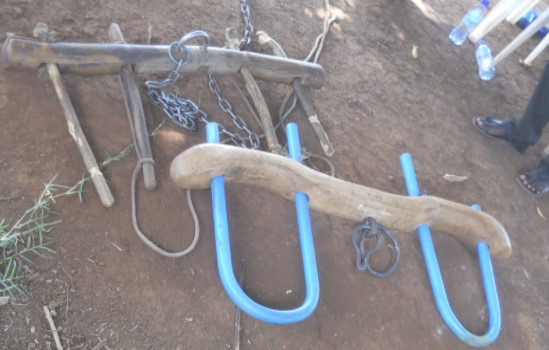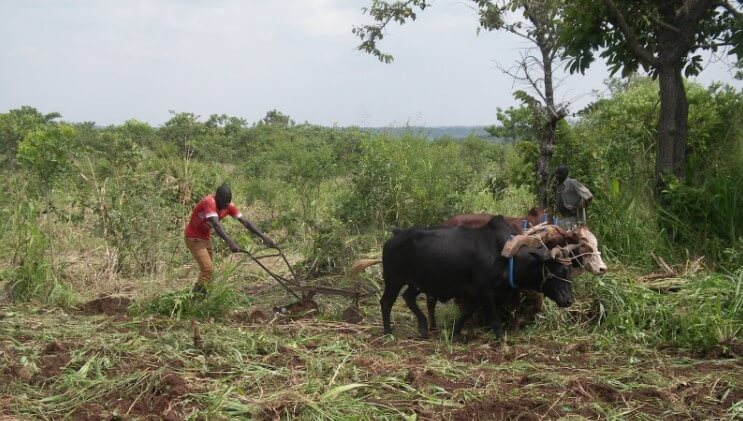What is an Ox?
Draft animals have been used by farmers around the world for thousands of years. They are economical, self replicating, and sustainable. They can be used for transporting crops, materials, water and people. In the field, Bos taurus are employed in plowing, planting, cultivating and harvesting.
The primary source of power is supplied by oxen. For those not familiar with the definition of an ox, it is any cattle (bull, steer, or cow) that has been domesticated and trained to work and is mature, generally 4 years of age or older.
The use of draft animals like Bos taurus is increasing in sub-Saharan Africa. (FAO. (2010). FAO: An Overview of Draught Animal Power . Retrieved January 27, 2021.)
Food insecurity is being addressed in many ways, from helping small farmers better understand and manage the use of fertilizers and irrigation to finding and developing better seed varieties to improving crop harvesting and storage.
One aspect that has received very little attention is improved methods of transferring the draft power of the oxen to the implement or cart that they are pulling, similar to how a tractor operates.
While horses use collars and harnesses to attach to what they are pulling, oxen use the ox yoke. The type of ox yoke can have a great effect on the amount of draft a team of oxen can exert.
What is an ox yoke ?
Ox yoke is a wooden beam used to harness two oxen together in order to pull heavy loads in agriculture. It is designed to distribute the weight evenly between the two animals, making it easier for them to work together.
The yoke is typically placed across the necks of the oxen and attached to the device or load they are pulling. This traditional farming tool has been used for centuries to help increase efficiency and productivity in the fields.
How does a traditional ox yoke work?

Fig1: Traditional ox yoke in use
The traditional ox yoke used in Africa and other locations is a pole laid across the necks of the ox team and held in place with sticks running on either side of the neck and tied underneath.
The pulling chain is attached between the animals either around the pole or to a bolt through the back of the pole. When the team begins moving forward, the direction of pull is downward toward the implement being pulled.
Since most traditional breeds of cattle in Africa and elsewhere have humps, this pulls the pole back against the hump and downward into the back of the neck. (Fig.1 and Fig. 2) A 2017 study (Ott, J. (2018). Evaluating the Effectiveness of a Farmer Field School in Northern Uganda through the Adoption of Improved Ox Yokes (Unpublished master’s thesis).
New Mexico State University, Las Cruces.), conducted by the author in Uganda, found that teams using the traditional ox yoke often suffered from sores and bruises on the neck and hump and could generally work only 3-4 hours in a day. Some teams were so tired after fieldwork that they delayed grazing until fully rested.

Fig2: Direction of draft
The benefits of the improved ox yoke

Fig3: Improved ox yoke in use
The same farmers in Uganda had received training in how to build and use an improved, Western-style ox yoke. This ox yoke has a shaped neck seat, u shaped bows and a lower attachment for the chain at the bottom of the ox yoke. (Fig. 3) This lower, dropped attachment point allows the ox yoke to rotate towards the ox when they pull.
The team issue then able to all of the neck and shoulder muscles to push against the bows, better distributing the pressure during work. This is more comfortable for the animals and especially important as the introduction of new genetics is causing a reduction and/or loss if the humps in many herds. When asked how their teams were working with improved ox yoke, the farmers reported that there was no more bruising and sores and that their teams could work longer hours with less fatigue.
The improved ox yoke is easily made by the farmers, with hardware produced by local blacksmiths. (Fig.4) Producing these items for sale can also generate income for the farmers and blacksmiths.
When working with farmers to increase food security, organizations should not neglect introducing innovative ways to make farm work more productive. Improvement to the ways that farmers work with their draft animals can greatly increase food production. The improved ox yoke has many benefits for both the farmer and the oxen:
- Increased draft power due to using neck and shoulder muscles
- Fewer sores and bruising due to the small contact area of the yoke
- Ability to work for longer periods of time
- Decreased fatigue following work on the ground.
- Ability to use animals with small or no hump

Fig4: Traditional and improved ox yokes
The utilization and contrast of oxen and horses
Horses have been used for centuries in a variety of capacities, including agriculture, transportation, and warfare. Their speed, strength, and agility make them ideal for pulling carts, plowing fields, and even carrying riders into battle.
However, in some cultures, oxen have also been used as draft animals, particularly for heavy pulling tasks. Unlike horses, oxen are typically larger and stronger, with a sturdy frame and distinctive horns.
They are often harnessed using a yoke and rope to pull heavy loads in fields or forests. While horses are more versatile and faster, oxen are better suited for tasks requiring brute strength and endurance.
FAQ
Q: What is the definition of an ox?
A: An ox is a domestic bovine that has been trained to work as a draft animal, typically used for pulling heavy loads or farming equipment.
Q: How is an ox different from a steer?
A: A steer is a castrated male bovine, while an ox is a working bovine trained to assist with tasks like plowing fields or hauling logs.
Q: How are oxen traditionally used in logging operations?
A: Oxen are used in logging to drag logs from forests to processing sites, as they are strong, sure-footed, and well-suited for the demanding task.
Q: Can oxen be raised for beef production?
A: Yes, oxen can be raised for beef production, as they are essentially working cattle that are later processed for meat once they have fulfilled their working duties.
Q: What role did oxen play in ancient civilizations?
A: In ancient times, oxen were crucial for agriculture, transportation, and even warfare in regions like Asia and Africa, where they were essential for plowing fields and pulling heavy loads.
Q: Are oxen known for their docile nature?
A: Yes, oxen are known for being docile animals, making them easier to handle and work with compared to other more aggressive livestock.
Q: How do oxen contribute to the productivity of agricultural activities?
A: Oxen are valuable for their strength and endurance, which help increase productivity on farms by assisting with tasks like plowing, pulling carts, and carrying heavy loads.


Very good article with excellent pictures
Thank you Mushtaq ! 🙏